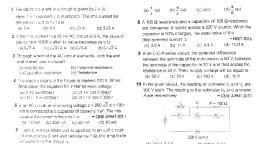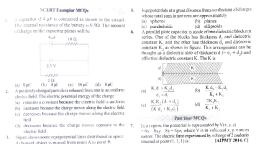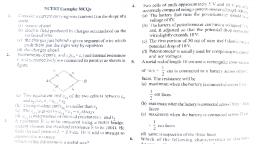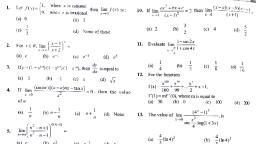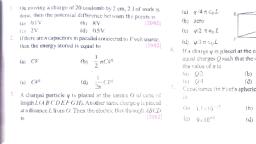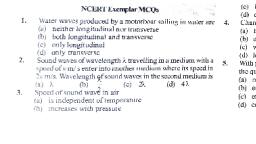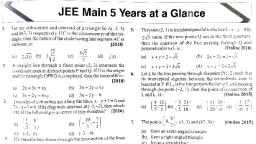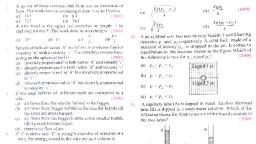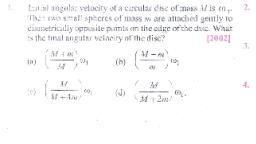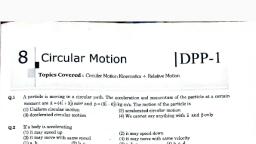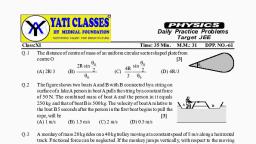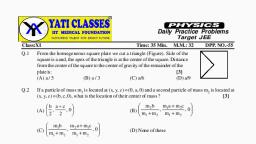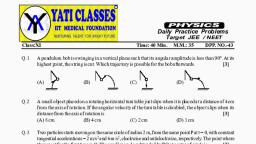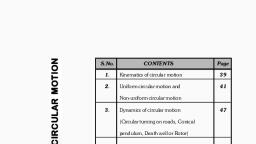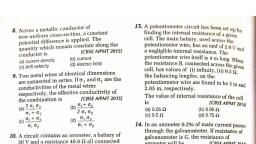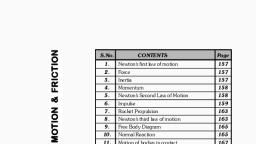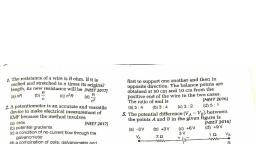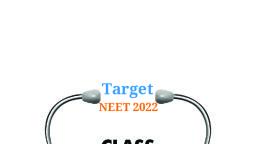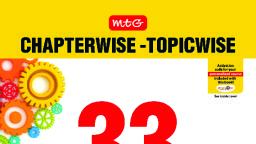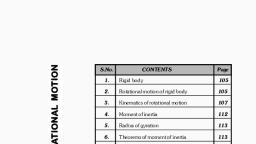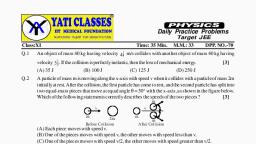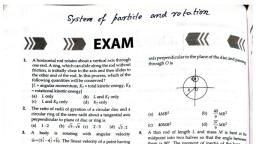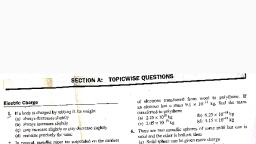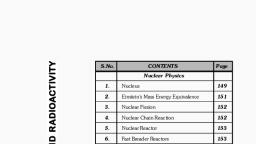Page 1 :
PHYSICS, , Daily Practice Problems, Class:XI, Q.1, , Discussion: 03-04/08/2015 Time: 35 Min., , Potential energy curve U of a particle as function of the position of a particle is shown. The particle has, total mechanical energy E of 3.0 joules., [3], , (A) It can never be present at x = 0 m., (C) At x = 2 its kinetic energy is 0 J, Q.2, , (B) It can never be present at x = 5 m., (D) At x = 1 its kinetic energy 3J., , The kinetic energy(KE) vs time graph for a particle moving along a straight line, is shown in the figure. The force vs time graph for the, particle may be, [3], , (A), , Q.3, , Target JEE, M.M.: 34, DPP. NO.-49, , (B), , (C), , (D), , You want to hit a small box on the floor with a marble fired from a spring-loaded gun that is mounted on, a table. The target box is a distance R horizontally from the edge of the table; see the figure. You, compress the spring a distance d, but the center of the marble falls short by a distance r of the center of, the box. How far (x) should you compress the spring to score a direct hit (neglect friction)?, [3], , (A) x =, , d2, R r, , (B) x =, , d (R r ), R, , (C) x =, , d (R r ), Rr, , (D) x =, , Rd, R r, PAGE # 1
Page 2 :
Q.4, , A particle is moving on x-axis has potential energy U = 2 – 20 X + 5x2 Joules along x-axis. The particle, is released at x = – 3. The maximum value of ‘x’ will be [x is in meters and U is in joules], [3], (A) 5 m, (B) 3 m, (C) 7 m, (D) 8 m, , Q.5, , Abox of mass m is initially at rest on a horizontal surface.Aconstant horizontal force of mg/2 is applied, to the box, directed to the right. The coefficient of friction of the surface changes with the distance, pushed as = 0x where x is the distance from the initial location. For what distance is the box pushed, until it comes to rest again?, [3], , 2, (A) , 0, Q.6, , 1, (C) 2, 0, , 1, (D) 4, 0, , , The work done by the force F x 2 î y 2 ˆj around the path shown in the figure, is, [3], , (A), Q.7, , 1, (B) , 0, , 2 3, a, 3, , (C) a3, , (B) zero, , (D), , 4 3, a, 3, , Aparticle is revolving in a circle of radius R with initial speed v. It starts retarding with constant retardation, v2, . The number of revolutions it makes before coming to rest is:, 4R, (A) 1, (B) 3, (C) 4, , [3], (D) none of these, , Q.8, , Statement-1 : In uniform circular motion acceleration is constant., [3], Statement-2 : In uniform circular motion, angular acceleration is constant., (A) Statement-1 is true, statement-2 is true and statement-2 is correct explanation for statement-1., (B) Statement-1 is true, statement-2 is true and statement-2 is NOT the correct explanation for statement-1., (C) Statement-1 is true, statement-2 is false., (D) Statement-1 is false, statement-2 is true, , Q.9, , V-t graph of an object of mass 1 kg is shown :, , [4], , V(m/s), 20, 10, 0, , 10, , 20, , 30, , t(sec), , (A) net work done on the object in 30 sec. is zero, (B) the average acceleration from 0 to 30 sec. of the object is zero, (C) the average velocity from 0 to 30 sec. of the object is zero, (D) the average force from 0 to 30 sec. on the object is zero, Q.10, , Assume that in space potential energy U-depends on x-coordinate only by :, U = (x – 3)2 (2 – x), A mass m can be kept on x-axis. In each position indicated in column-I, comment on the situation from, column-II., [6], Column I, Column II, (A), x = 7/3, (P), Stable equilibrium, (B), x=2, (Q), Unstable equilibrium, (C), x=3, (R), Neutral equilibrium, (S), Not in equilibrium, PAGE # 2
Page 3 :
PHYSICS, , Daily Practice Problems, Class:XI (P), Q.1, , Discussion: 05-06/08/2015 Time: 35 Min., , Target JEE, M.M.: 35, DPP. NO.-50, , A system comprises of two small spheres with same masses 'm'. The spring is non deformed. The, spheres are set in motion in gravity free space at the velocities as shown in the diagram., , 0, , v0, m, , k, , m, , v0, , The maximum elastic potential Energy stored in the system is., mv 02, (A), 2 2, Q.2, , (B) mv02, , (C), , 1, mv 02, 2, , [3], (D) 2mv02, , A boy blowing a whistle sends out air at one gram per second with a speed of 200 m/s. Find his lung, power, [3], (A) 20 W, (B) 0.2 W, (C) 2 W, (D) 200 W, Paragraph for question nos. 3 to 4, Apuck is moving in a circle of radius r0 with a constant speed v0 on a level frictionless table.Astring is, attached to the puck, which holds it in the circle; the string passes through a frictionless hole and is, attached on the other end to a hanging object of mass M., , Q.3, , The puck is now made to move with a speed v' = 2v0, but still in a circle. The mass of the hanging object, is left unchanged. The acceleration a' of the puck and the radius r' of the circle are now given by [3], , (A) a' = 4a0 and r' = r0, (C) a' = 2a0 and r' = 2r0, Q.4, , (B) a' = 2a0 and r' = r0, (D) a' = a0 and r' = 4r0, , The puck continues to move at speed v' = 2v0 in a circle, but now the mass of the hanging object is, doubled. the acceleration a' of the puck and the radius r' of the circle are now given by, (A) a' = 4a0 and r' = r0, (B) a' = 2a0 and r' = r0, (C) a' = 2a0 and r' = 2r0, (D) a' = a0 and r' = 4r0, , PAGE # 3
Page 4 :
Paragraph for question nos. 5 to 7, An elevator car has a mass of 1400 kg and is carrying passengers having a combined mass of 200 kg.A, constant friction force of 4000 N opposes its motion., , The elevator cable can withstand a maximum tension of 28000 N. It is being driven by a motor fixed at, the top., Q.5, , How much power must the motor deliver to lift the elevator car and its passengers at a constant speed of, 3 m/s., [3], (A) 6 × 104 W, (B) 4.8 × 104 W, (C) 1.2 × 104 W, (D) 3.6 × 104 W, , Q.6, , The elevator is moving upwards. What can not be a possible acceleration of the elevator., (A) 5 m/s2 , (B) 10 m/s2 , (C) 14 m/s2 , (D) 8 m/s2 , , [3], , Q.7, , Consider a time when elevator is moving up and retarding :, (A) The power supplied by the motor must be negative, (B) The power supplied by the motor must be positive, (C) The power supplied by the motor must be zero, (D) The power supplied by the motor may be positive., , [3], , Q.8, , In the adjoining figure blockAis of mass m and block B is of mass 2m. The spring has a force constant, k. All the surfaces are smooth and the system is released from rest with spring unstretched, [4], A, B, , (A) The maximum extension of the spring is, , 4mg, k, , (B) The speed of block Awhen extension in spring is, , 2mg, 2m, , is 2g, k, 3k, , (C) Net acceleration of block B when the extension in the spring is maximum, is, , 2, g., 3, , 2mg, in spring is mg., k, A particle is being acted upon by one dimensional conservative force. In F-x curve shown, four points, A,B,C,D are marked on the curve, for these points., [4], F, (A)Aand D are equilibrium points, D, (B) B and C are equilibrium points, C, E, B, (C)Ais stable and D is unstable equilibrium point, x, (D) B is unstable and C is stable equilibrium point, A, , (D) Tension in the thread for extension of, , Q.9, , PAGE # 4
Page 5 :
Q.10, , Column-I shows certain situations and column-2 shows information about forces., Column - I, Column - II, , [6], , Situation, F3, F1, , (A), , (P), , F2, Front view of a car, rounding a curve with, constant speed., , (B), , , F1, , , F3, , , F1 F2 F3 is centripetal force., , , (Q) F1 is static friction., , •, F2, , Passengers in a rotor not, sliding relative to rotor wall, cylindrical rotor is rotating with, constant angular velocity about, its symmetry axis., , , , F3, , (C), , , F1, , , F2, Particle kept on rough surface, of a bowl, no relative motion, of particle in bowl, bowl has, constant angular velocity, , (D), F3, , , (R) F1 can beindirection opposite to thatshown in figure., , , (S) F1 F2 0, , F1, , Car moving on a banked road, with constant speed, no, sideways skidding, F2, , , (T) F1 F2 F3 0, , PAGE # 5
Page 6 :
PHYSICS, , Daily Practice Problems, Class:XI (P), Q.1, , Discussion: 07-08/08/2015 Time: 35 Min., , Target JEE, M.M.: 34, DPP. NO.-51, , Figure shows a smooth track in a vertical plane, consisting of two circular arcsAB and BC of the same, radius R = 2m. The common tangent to the arcs, BD, is horizontal.Asmall block placed on the track at, a height h above BD leaves the track at exactly the same depth below. Determine h in cm., [3], A, R, h, B, , D, h, R, C, , (A) 10 cm, Q.2, , (B) 20 cm, , (C) 40 cm, , (D) 80 cm, , A particle tied to one end of a string is being rotated in a vertical circle with constant frequency. The, tension in the string at points A, B, C and D are T1, T2, T3 and T4 respectively. Then[3], C, , D, , O, , B, , A, , (A) T1 = T2 = T3 = T4, (C) T1 > T3 > T2 , T2 = T4, Q.3, , (B) T1 > T2 > T3 , T2 = T4, (D) T1 < T2 < T3 , T2 = T4, , A ball of mass 1 kg hanges from a string as shown. It is projected from the lowest point with a velocity, of 10 m/s. Find the speed of the ball when the tension in the string is equal to its weight., [3], 1m, 10 m/s, , (A) 5 2 m/s, Q.4, , (B), , 10, m/s, 3, , (C) 5 3 m/s, , (D) 2.5 m/s, , A small pendulum bob of mass 'm' is suspended from a string of length L, whose upper end is fixed at, point O. At the lowest point, the bob is imparted a horizontal velocity v0 =, = angle which the string makes with the vertical. The maximum value of will be, (A) 60°, (B) 45°, (C) 30°, (D) cos–1(3/4), , (gL) . Let, [3], , PAGE # 6
Page 7 :
Question No. 5 to 8 (4 questions), A block of mass m is kept in an elevation which starts moving downward with, an acceleration a as shown in figure. The block is observed by two, observers Aand B for a time interval t0., Q.5, , The observer B finds that the work done by gravity on the block is, (A), , 1, mg 2 t 02, 2, , (B) –, , 1, mg 2 t 02, 2, , (C), , 1, mgat 02, 2, , [3], (D) –, , 1, mgat 02, 2, , Q.6, , The observer B finds that the work done by pseudo force on the block is, (A) zero, (B) – ma2t0, (C) + ma2t0, (D) – mgat0, , [3], , Q.7, , According to observer B, the net work done on the block is, , [3], , (A) –, Q.8, , Q.9, , 1, ma 2 t 02, 2, , (B), , 1, ma 2 t 02, 2, , (C), , According to the observer A, (A) the work done by gravity is zero, (C) the work done by pseudo force is zero, , 1, mgat 02, 2, , (D) –, , 1, mgat 02, 2, , [3], (B) the work done by normal reaction is zero, (D) all the above, , As shown in figure BEF is a fixed vertical circular tube.Ablock of mass m starts moving in the tube at, point B with velocity V towards E. It is just able to complete the vertical circle, then, [4], , C, B, , F, , 60° R, E, , (A) velocity at B must be 3Rg ., (C) Normal reaction at point F is 2mg., , (B) velocity at F must be 2Rg ., (D) The normal reaction at point E is 6 mg., , PAGE # 7
Page 8 :
Q.10, , In column-I, a situation is depicted each of which is in vertical plane. The surfaces are frictionless. Match, with appropriate entries in column-II., [6], Column-I, Column-II, (A), Bead is threaded on a circular, (P), Normal force is zero at top most, R = 1m, fixed wire and is projected, point of its trajectory., from the lowest point., 5m/s, , (B), , Block looselyfits inside the, fixed small tube and is, projected from lowest point, , (Q), , Velocity of the body is zero at top, most point of its trajectory, , (R), , Acceleration of the body is zero, at the top most point of its trajectory, , (S), , Normal force is radially outward, at top most point of trajectory., , R =1m, , 20 m/s, , (C), , Block is projected horizontally, from lowest point of a smooth, fixed cylinder., , R = 1m, , 6m/s, , (D), , Block is projected on a, fixed hemisphere from, angular position ., , 20, m/s, 3, , R=1m, cos = 2/3, , PAGE # 8

